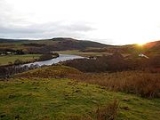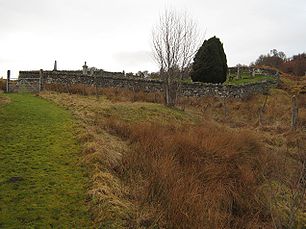
Battle of Tuiteam Tarbhach
Encyclopedia


Scottish clan
Scottish clans , give a sense of identity and shared descent to people in Scotland and to their relations throughout the world, with a formal structure of Clan Chiefs recognised by the court of the Lord Lyon, King of Arms which acts as an authority concerning matters of heraldry and Coat of Arms...
battle in which the Mackays
Clan MacKay
Clan Mackay is an ancient and once powerful Scottish clan from the far north of the Scottish Highlands, but with roots in the old kingdom of Moray. They were a powerful force in politics beginning in the 14th century, supporting Robert the Bruce. In the centuries that followed they were...
wiped out raiders from the Clan MacLeod of Lewis
Clan MacLeod of Lewis
Clan Macleod of The Lewes, commonly known as Clan MacLeod of Lewis, is a Highland Scottish clan, which at its height held extensive lands in the Western Isles and west coast of Scotland. From the 14th century up until the beginning of the 17th century there were two branches of Macleods: the...
who were returning from an attack on Mackay land in Strathnaver
Strathnaver
Strathnaver or Strath Naver is the fertile strath of the River Naver, a famous salmon river that flows from Loch Naver to the north coast of Scotland...
. The Mackays caught up with the raiders on the north bank of the River Oykel
River Oykel
The River Oykel is a major river in northern Scotland that is famous for its salmon fishing. It rises on Ben More Assynt, a few miles from Ullapool on the west coast of Scotland, and drains into the North Sea via the Kyle of Sutherland...
some three miles west of where the river joins the River Cassley
River Cassley
The River Cassley in Sutherland, in northern Scotland, drains into the Kyle of Sutherland at Invercassley , a short distance below where the River Oykel flows into the Kyle. The Kyle is subsequently joined by the River Shin about Inveran, before it becomes the Dornoch Firth at Bonar Bridge, into...
at the head of the Kyle of Sutherland
Kyle of Sutherland
Kyle of Sutherland is a river estuary that separates Sutherland from Ross-shire. It flows into the Dornoch Firth and is fed by the rivers Oykel, Shin, River Cassley and Carron.The downstream extent of the Kyle of Sutherland is the bridge at Bonar Bridge...
. The battle probably took place in 1406, but the date is uncertain from the manuscripts.
Background
Angus Mackay of Strathnaver had married Sidheag, sister of Roderick, chief of the MacLeods. When Angus died, he left his brother Black Hugh (Uistean Dow or Houcheon Dubh) as regentRegent
A regent, from the Latin regens "one who reigns", is a person selected to act as head of state because the ruler is a minor, not present, or debilitated. Currently there are only two ruling Regencies in the world, sovereign Liechtenstein and the Malaysian constitutive state of Terengganu...
("tutor") for his two sons Angus Dow (Dubh) and Rory Gald (Roderick Gald, "Lowland"). When Roderick heard that his sister was in dispute with Hugh Mackay in 1406, he decided to resolve the matter by sending a company of men to the Reay Country, the Mackay lands that bordered Caithness. The men were led by Roderick's brother, Malcolm (Máel Coluim or Maol Choluim) MacLeod, later known as Gille-caluim Beag, Gill-callum-beg-Macbhowan or Gilealm Beg McBowen ("Malcolm the Little"); "gille" had come to replace "maol" in such names.
Failing to come to an amicable agreement, Malcolm ravaged Mackay lands in Strathnaver
Strathnaver
Strathnaver or Strath Naver is the fertile strath of the River Naver, a famous salmon river that flows from Loch Naver to the north coast of Scotland...
, and the Sutherland district of Brae-Chat (Breachat), around Lairg
Lairg
Lairg is a village in Sutherland, Highland, Scotland. It has a population of about 700and is situated at the south-eastern end of Lairg is a village in [[Sutherland]], [[Highland |Highland]], [[Scotland]]...
at the south end of Loch Shin
Loch Shin
Loch Shin is a loch in the Scottish North West Highlands. To the south is the small town of Lairg. The loch is the largest in Sutherland, runs from the north-west to the south-east and is 17 miles long....
. This provoked both the Mackays and Robert Earl of Sutherland
Earl of Sutherland
Earl of Sutherland is a title in the Peerage of Scotland. It was created circa 1230 for William de Moravia. The Earl of Sutherland is also the Chief of Clan Sutherland...
, the latter sending a company of men under Alexander Murray of Cubin (Alistair Ne-Shrem-Gorme) to join Hugh Mackay in pursuit of the raiders.
Battle plans
The River Oykel and its estuary the Kyle of Sutherland stretch across the Highlands from Dornoch on the east coast almost to Ullapool on the west coast. The river is the traditional boundary between SutherlandSutherland
Sutherland is a registration county, lieutenancy area and historic administrative county of Scotland. It is now within the Highland local government area. In Gaelic the area is referred to according to its traditional areas: Dùthaich 'IcAoidh , Asainte , and Cataibh...
to the north and Ross
Ross
Ross is a region of Scotland and a former mormaerdom, earldom, sheriffdom and county. The name Ross allegedly derives from a Gaelic word meaning a headland - perhaps a reference to the Black Isle. The Norse word for Orkney - Hrossay meaning horse island - is another possible origin. The area...
to the south, and is a major transport artery linking the East Coast to the MacLeod territory of Assynt in the west. The Mackays and Sutherland men caught up with the MacLeods as they were crossing the Tutim Burn, laden down by booty and stolen cattle.
Battle
Initially Mackay tried to just recover his property. When the MacLeods objected, a "long, furious, cruel, and doubtful...rather desperate than resolute" battle ensued, which ended with the slaughter of all the MacLeods except one, who managed to return to Lewis and report the defeat before dying of his wounds.Aftermath
Angus Dow succeeded his uncle as chief of the Mackays when Hugh died two years later. Despite his defeat by Donald, Lord of the Isles, at the Battle of DingwallBattle of Dingwall
The Battle of Dingwall was a Scottish clan battle said to have taken place in the year 1411, in Dingwall in the Scottish Highlands. It was fought between the Clan Mackay against the Clan Donald.-Sir Robert Gordon:...
in 1411, the Mackays appear to have prospered and expanded under Angus Dow and he is regarded as the ancestor of all the Mackay chiefs. By 1427 he was important enough to be one of the chiefs summoned to a parliament in Inverness, where they were arrested by James I
James I of Scotland
James I, King of Scots , was the son of Robert III and Annabella Drummond. He was probably born in late July 1394 in Dunfermline as youngest of three sons...
. At that time he had 4000 men under his command according to the Scotichronicon
Scotichronicon
The Scotichronicon is a 15th-century chronicle or legendary account, by the Scottish historian Walter Bower. It is a continuation of historian-priest John of Fordun's earlier work Chronica Gentis Scotorum beginning with the founding of Scotland of mediaeval legend, by Scota with Goídel...
; such power led to his nickname of Enneas-en-Imprissi, "Angus the Absolute".
Numerous cairn
Cairn
Cairn is a term used mainly in the English-speaking world for a man-made pile of stones. It comes from the or . Cairns are found all over the world in uplands, on moorland, on mountaintops, near waterways and on sea cliffs, and also in barren desert and tundra areas...
s once marked the battlefield, but their stones have since been used for building dry stone walls. A cemetery was later built on the hillside to the east of the battlefield; according to local legend the cemetery wall was built from the cairns. Today the A837 road runs through the battlefield.
See also
- Battle of HarlawBattle of HarlawThe Battle of Harlaw was a Scottish clan battle fought on 24 July 1411 just north of Inverurie in Aberdeenshire. It was one of a series of battles fought during the Middle Ages between the barons of northeast Scotland against those from the west coast....
(1411) - after Dingwall, the Mackays joined the Lord of the Isles in his attempt to seize the Earldom of Ross - Battle of HarpsdaleBattle of HarpsdaleThe Battle of Harpsdale was a Scottish clan battle fought in 1426 at Achardale, about south of Thurso. The Clan Mackay had invaded Caithness from the west and Harpsdale was where the local clans of Gunn and Keith chose to make a stand...
(1426) - Mackay raid into Caithness - Battle of DrumnacoubBattle of DrumnacoubThe Battle of Drumnacoub was a battle involving factions of the Clan Mackay fought in the far northwest of Scotland, some time between 1427 and 1433. It took place on a hill called Carn Fada at the southern end of the Kyle of Tongue, between Ben Loyal and the village of Tongue...
(1429 or 1431) - near Tongue, decisive battle of civil war between Angus Dow's offspring - Battle of AuldicharishBattle of AuldicharishThe Battle of Aldy Charrish was a Scottish clan battle that took place on 11 July 1487...
(1487) - Mackays defeated Clan Ross in Strathcarron after a raid on Strathoykel

